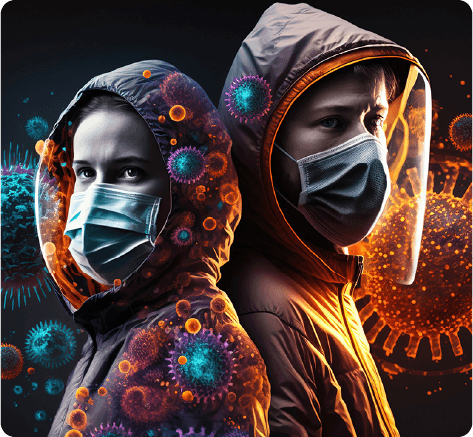Home >> Company History

The unfortunate passing of the founder’s mother during the Covid-19 pandemic in 2020 served as the catalyst for the development of a groundbreaking smart textile solution. This innovation, known as Sense-Tex, is designed to provide real-time health metrics and prompt responses while maintaining a high level of comfort, circularity, and sustainability.
The founder was motivated by the desire to enhance the well-being of loved ones, seeking to create a solution that would not only facilitate safe social interactions and combat isolation but also prioritize sustainability throughout the entire supply chain.
Bringing together the expertise of a Space Engineer in 2021 and Textile Engineers from Turkey in 2022, the vision of Sense-Tex was transformed into a reality.

Transforming Textiles AB was founded on December 21st, 2020 by Sara Rosberg. In 2021, Marcelo Bolt, a Space Engineer, joined the company as the Head of Technical Development. Together, they embarked on a journey to create an innovative smart textile solution.
Following the successful completion of the first Minimum Viable Product (MVP), Sara collaborated with Tahir Haytoglu, the Supply Chain Manager in Turkey, to further research and develop the textile manufacturing process for Sense-Tex. This collaboration led to partnerships with major textile factories in Turkey that produce for renowned global brands, solidifying Transforming Textiles AB’s position in the textile industry.
The initial MVP prototype, a result of Sara and Marcelo’s collaborative efforts, combined advanced sensor technology with
high-performance threads and textiles. By leveraging the innate antiseptic and exoskeleton properties of these textiles, they were able to collect valuable data from custom sensors and enhance it through near real-time satellite communication infrastructure.
In the next phase of product development, Transforming Textiles AB integrated the patented Vitals Traks sensor solution (by Vitalprobe) into their processes, replacing the use of custom sensors. This phase also involved the development of Sense-Tex Yarn-thread technology and the establishment of manufacturing processes across three different factories in Turkey, ensuring chemical-free production of the new yarn technology.
IDEON Innovation Incubation Period
In September 2022, Transforming Textiles AB was admitted into the BUILD program and relocated its office to IDEON Science Park/Innovation in Lund, Sweden. This strategic move aimed to secure investments and propelled the company towards the next phase of product development.
Testbed
Our commitment to ensuring the safety of individuals led us to conduct SEM test analyses through Swerim, analysing the material on a micro level.
We also preformed several chemical tests as well as ISO quality and safety tests through Mesurlabs in Finland. Please read more on
www.sense-tex.com.
We also conducted testbeds on humans in a gym, with a personal trainer present to analyse the performance, comfort, and behaviour of Sense-Tex in practical environments.
These tests confirm that the materials and conductors used in our products do not pose any harm. Moving forward, we plan to establish a formal Testbed and a long-term Virus research project in collaboration with Aerosol Labs to test different virus strains and environments for the material.
Certification Friend of Sea/Earth
Transforming Textiles AB has a strong commitment to environmental conservation and sustainability. We are proud to be associated with organizations like Friend of the Sea and Friend of the Earth, which share our values and goals. Friend of the Sea, a non governmental organization established in 2008, focuses on safeguarding the marine environment and its resources. Their approach
involves promoting a sustainable market and implementing targeted conservation projects.
By incentivizing sustainable practices, Friend of the Sea contributes to the preservation of our precious oceans. On the other hand, Friend of the Earth operates a certification program specifically tailored to products from sustainable agriculture and farming. Over time, this certification has expanded to cover a wider range of products and services that meet stringent sustainability requirements. This demonstrates the organization’s dedication to promoting sustainability in various sectors.
Both organizations set forth requirements for certification, which are classified as Essential or Recommendations based on their level of importance. Essential requirements are mandatory for certification, and a company must achieve 100% conformity to these requirements. In the event of non-conformity, the company is required to propose effective corrective actions within three weeks. This proposal should include a declaration of intents and an implementation plan, along with a timetable for each corrective measure. The company must fully implement these corrective actions within the following 12 months, which will be verified during the surveillance audit.
On the other hand, compliance with recommendations is not mandatory for certification. However, during the audit, any deficiencies in meeting the recommendations will be included in the Audit Report as recommendations. The company is expected to inform the certification body about any corrective measures implemented during the subsequent audit. At Transforming Textiles AB, we strive to exceed both the essential requirements and recommendations set forth by these organizations. Our commitment to sustainability is not only about certification but about making a positive impact on the environment and society as a whole.
FOR MORE DETAILS VISIT
Transformingtextiles © 2024 | By MAANAQ
Transforming Textiles
We firmly believe that the internet should be available and accessible to anyone, and are committed to providing a website that is accessible to the widest possible audience, regardless of circumstance and ability.
To fulfill this, we aim to adhere as strictly as possible to the World Wide Web Consortium’s (W3C) Web Content Accessibility Guidelines 2.1 (WCAG 2.1) at the AA level. These guidelines explain how to make web content accessible to people with a wide array of disabilities. Complying with those guidelines helps us ensure that the website is accessible to all people: blind people, people with motor impairments, visual impairment, cognitive disabilities, and more.
This website utilizes various technologies that are meant to make it as accessible as possible at all times. We utilize an accessibility interface that allows persons with specific disabilities to adjust the website’s UI (user interface) and design it to their personal needs.
Additionally, the website utilizes an AI-based application that runs in the background and optimizes its accessibility level constantly. This application remediates the website’s HTML, adapts Its functionality and behavior for screen-readers used by the blind users, and for keyboard functions used by individuals with motor impairments.
If you’ve found a malfunction or have ideas for improvement, we’ll be happy to hear from you. You can reach out to the website’s operators by using the following email
Our website implements the ARIA attributes (Accessible Rich Internet Applications) technique, alongside various different behavioral changes, to ensure blind users visiting with screen-readers are able to read, comprehend, and enjoy the website’s functions. As soon as a user with a screen-reader enters your site, they immediately receive a prompt to enter the Screen-Reader Profile so they can browse and operate your site effectively. Here’s how our website covers some of the most important screen-reader requirements, alongside console screenshots of code examples:
Screen-reader optimization: we run a background process that learns the website’s components from top to bottom, to ensure ongoing compliance even when updating the website. In this process, we provide screen-readers with meaningful data using the ARIA set of attributes. For example, we provide accurate form labels; descriptions for actionable icons (social media icons, search icons, cart icons, etc.); validation guidance for form inputs; element roles such as buttons, menus, modal dialogues (popups), and others. Additionally, the background process scans all the website’s images and provides an accurate and meaningful image-object-recognition-based description as an ALT (alternate text) tag for images that are not described. It will also extract texts that are embedded within the image, using an OCR (optical character recognition) technology. To turn on screen-reader adjustments at any time, users need only to press the Alt+1 keyboard combination. Screen-reader users also get automatic announcements to turn the Screen-reader mode on as soon as they enter the website.
These adjustments are compatible with all popular screen readers, including JAWS and NVDA.
Keyboard navigation optimization: The background process also adjusts the website’s HTML, and adds various behaviors using JavaScript code to make the website operable by the keyboard. This includes the ability to navigate the website using the Tab and Shift+Tab keys, operate dropdowns with the arrow keys, close them with Esc, trigger buttons and links using the Enter key, navigate between radio and checkbox elements using the arrow keys, and fill them in with the Spacebar or Enter key.Additionally, keyboard users will find quick-navigation and content-skip menus, available at any time by clicking Alt+1, or as the first elements of the site while navigating with the keyboard. The background process also handles triggered popups by moving the keyboard focus towards them as soon as they appear, and not allow the focus drift outside it.
Users can also use shortcuts such as “M” (menus), “H” (headings), “F” (forms), “B” (buttons), and “G” (graphics) to jump to specific elements.
We aim to support the widest array of browsers and assistive technologies as possible, so our users can choose the best fitting tools for them, with as few limitations as possible. Therefore, we have worked very hard to be able to support all major systems that comprise over 95% of the user market share including Google Chrome, Mozilla Firefox, Apple Safari, Opera and Microsoft Edge, JAWS and NVDA (screen readers).
Despite our very best efforts to allow anybody to adjust the website to their needs. There may still be pages or sections that are not fully accessible, are in the process of becoming accessible, or are lacking an adequate technological solution to make them accessible. Still, we are continually improving our accessibility, adding, updating and improving its options and features, and developing and adopting new technologies. All this is meant to reach the optimal level of accessibility, following technological advancements. For any assistance, please reach out to